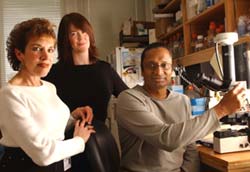Articles and reports from the Life Sciences and chemistry area deal with applied and basic research into modern biology, chemistry and human medicine.
Valuable information can be found on a range of life sciences fields including bacteriology, biochemistry, bionics, bioinformatics, biophysics, biotechnology, genetics, geobotany, human biology, marine biology, microbiology, molecular biology, cellular biology, zoology, bioinorganic chemistry, microchemistry and environmental chemistry.

A protein released from the lungs of a developing mouse fetus initiates a cascade of chemical events leading to the mother’s initiation of labor, researchers at UT Southwestern Medical Center at Dallas have found.
The research, which has implications for humans, marks the first time a link between a specific fetal lung protein and labor has been identified, said Dr. Carole Mendelson, professor of biochemistry and obstetrics and gynecology and senior author of the study. The paper appear

Scientists studying the elusive western gorilla observed that neighboring social groups have surprisingly peaceful interactions, in contrast to the aggressive male behavior well documented in mountain gorillas. By analyzing the DNA from fecal and hair samples of the western gorilla, scientists uncovered evidence that these neighboring social groups are often led by genetically related males. These findings suggest connections between genetic relationships and group interactions, parallels with human

System for guiding cell migration, adhesion has biomedical and regenerative medical applications
Scientists at the University of Toronto are taking regenerative medicine to a new dimension with a process for guiding nerve cells that could someday help reconnect severed nerve endings.
Molly Shoichet, a professor of chemical engineering and applied chemistry at the Institute for Biomaterials and Biomedical Engineering (IBBME), has devised a new method that helps guide cell mi

A novel application of microarray technology, where up to 30,000 whole genomes are printed on a single slide, is described in the journal BMC Microbiology this week. The ‘Library on a Slide’ will help researchers compare the genetic make up of large numbers of bacterial strains to discover which genes are responsible for causing disease.
Even within one species of bacteria, the genetic content can vary by as much as 25% between individual strains. These differences can determine how virulent

Researchers at the Center for Biomedical Inventions at UT Southwestern Medical Center at Dallas have identified the genetic changes that Mycobacterium tuberculosis, the bacterium that causes tuberculosis, undergoes during infection of a living host.
For the first time, researchers have adapted gene-chip technology to carry out genomic analysis of gene expression during the course of infection not only for M. tuberculosis, but for any pathogen. The findings will appear in an upcoming issue

Two studies published in the online issue of Nature report no evidence to suggest that hematopoietic stem cells, which usually produce blood cells, can turn into heart cells after injection into the heart. These studies raise a cautionary note for interpreting the results of ongoing clinical studies in which hematopoietic stem cells are injected into the heart after a heart attack.
Loren Field, Ph.D., professor of medicine and of pediatrics at the Indiana University School of Medicine and s